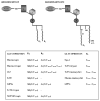Inositolphosphoceramide metabolism in Trypanosoma cruzi as compared with other trypanosomatids
- PMID: 21332877
- PMCID: PMC3444516
- DOI: 10.1111/j.1550-7408.2011.00533.x
Inositolphosphoceramide metabolism in Trypanosoma cruzi as compared with other trypanosomatids
Abstract
Chagas disease is caused by Trypanosoma cruzi and is endemic to North, Central and South American countries. Current therapy against this disease is only partially effective and produces adverse side effects. Studies on the metabolic pathways of T. cruzi, in particular those with no equivalent in mammalian cells, might identify targets for the development of new drugs. Ceramide is metabolized to inositolphosphoceramide (IPC) in T. cruzi and other kinetoplastid protists whereas in mammals it is mainly incorporated into sphingomyelin. In T. cruzi, in contrast to Trypanosoma brucei and Leishmania spp., IPC functions as lipid anchor constituent of glycoproteins and free glycosylinositolphospholipids (GIPLs). Inhibition of IPC and GIPLs biosynthesis impairs differentiation of trypomastigotes into the intracellular amastigote forms. The gene encoding IPC synthase in T. cruzi has been identified and the enzyme has been expressed in a cell-free system. The enzyme involved in IPC degradation and the remodelases responsible for the incorporation of ceramide into free GIPLs or into the glycosylphosphatidylinositols anchoring glycoproteins, and in fatty acid modifications of these molecules of T. cruzi have been understudied. Inositolphosphoceramide metabolism and remodeling could be exploited as targets for Chagas disease chemotherapy.
© 2011 The Author(s). Journal of Eukaryotic Microbiology© 2011 International Society of Protistologists.
Figures




Similar articles
-
Glycoinositolphospholipids, free and as anchors of proteins, in Trypanosoma cruzi.Curr Pharm Des. 2001 Aug;7(12):1165-79. doi: 10.2174/1381612013397519. Curr Pharm Des. 2001. PMID: 11472260 Review.
-
Formation and remodeling of inositolphosphoceramide during differentiation of Trypanosoma cruzi from trypomastigote to amastigote.Eukaryot Cell. 2003 Aug;2(4):756-68. doi: 10.1128/EC.2.4.756-768.2003. Eukaryot Cell. 2003. PMID: 12912895 Free PMC article.
-
Evidence for phospholipases from Trypanosoma cruzi active on phosphatidylinositol and inositolphosphoceramide.Biochem J. 2000 Jan 1;345 Pt 1(Pt 1):77-84. Biochem J. 2000. PMID: 10600641 Free PMC article.
-
The superfamily keeps growing: Identification in trypanosomatids of RibJ, the first riboflavin transporter family in protists.PLoS Negl Trop Dis. 2017 Apr 13;11(4):e0005513. doi: 10.1371/journal.pntd.0005513. eCollection 2017 Apr. PLoS Negl Trop Dis. 2017. PMID: 28406895 Free PMC article.
-
Searching the Tritryp genomes for drug targets.Adv Exp Med Biol. 2008;625:133-40. doi: 10.1007/978-0-387-77570-8_11. Adv Exp Med Biol. 2008. PMID: 18365664 Free PMC article. Review.
Cited by
-
Genome-scale metabolic models highlight stage-specific differences in essential metabolic pathways in Trypanosoma cruzi.PLoS Negl Trop Dis. 2020 Oct 6;14(10):e0008728. doi: 10.1371/journal.pntd.0008728. eCollection 2020 Oct. PLoS Negl Trop Dis. 2020. PMID: 33021977 Free PMC article.
-
Substrate specificity of the neutral sphingomyelinase from Trypanosoma brucei.Parasitology. 2019 Apr;146(5):604-616. doi: 10.1017/S0031182018001853. Epub 2018 Nov 5. Parasitology. 2019. PMID: 30392480 Free PMC article.
-
Comparative sphingolipidomics of disease-causing trypanosomatids reveal unique lifecycle- and taxonomy-specific lipid chemistries.Sci Rep. 2017 Oct 19;7(1):13617. doi: 10.1038/s41598-017-13931-x. Sci Rep. 2017. PMID: 29051559 Free PMC article.
-
Everybody needs sphingolipids, right! Mining for new drug targets in protozoan sphingolipid biosynthesis.Parasitology. 2018 Feb;145(2):134-147. doi: 10.1017/S0031182017001081. Epub 2017 Jun 22. Parasitology. 2018. PMID: 28637533 Free PMC article. Review.
-
Extracellular Vesicles: Potential Role in Remote Signaling and Inflammation in Trypanosoma cruzi-Triggered Disease.Front Cell Dev Biol. 2021 Dec 20;9:798054. doi: 10.3389/fcell.2021.798054. eCollection 2021. Front Cell Dev Biol. 2021. PMID: 34988085 Free PMC article. Review.
References
-
- Abuin G, Couto AS, de Lederkremer RM, Casal OL, Galli C, Colli W, Alves MJ. Trypanosoma cruzi: the Tc-85 surface glycoprotein shed by trypomastigotes bears a modified glycosylphosphatidylinositol anchor. Exp Parasitol. 1996;82:290–297. - PubMed
-
- Agusti R, Couto AS, Campetella OE, Frasch AC, de Lederkremer RM. The trans-sialidase of Trypanosoma cruzi is anchored by two different lipids. Glycobiology. 1997;7:731–735. - PubMed
-
- Armesto J, Hannappel E, Leopold K, Fischer W, Bublitz R, Langer L, Cumme GA, Horn A. Microheterogeneity of the hydrophobic and hydrophilic part of the glycosylphosphatidylinositol anchor of alkaline phosphatase from calf intestine. Eur J Biochem. 1996;238:259–269. - PubMed
-
- Bertello LE, Andrews NW, de Lederkremer RM. Developmentally regulated expression of ceramide in Trypanosoma cruzi. Mol Biochem Parasitol. 1996;79:143–151. - PubMed
-
- Bertello LE, Alves MJ, Colli W, de Lederkremer RM. Inositolphosphoceramide is not a substrate for the first steps in the biosynthesis of glycoinositolphospholipids in Trypanosoma cruzi. Mol Biochem Parasitol. 2004;133:71–80. - PubMed
Publication types
MeSH terms
Substances
Grants and funding
LinkOut - more resources
Full Text Sources
Miscellaneous

